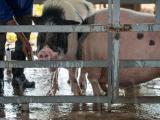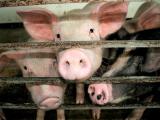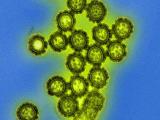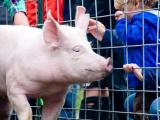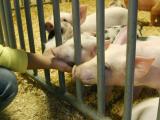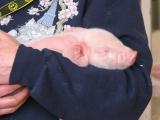Oct 25, 2012 (CIDRAP News) – Researchers report that swine and human influenza A/H3N2 viruses associated with an Ohio county fair held in July make a nearly perfect genetic match, suggesting that there is almost no biological barrier to prevent such viruses from passing between humans and pigs.
The authors sequenced the genomes of H3N2 viruses isolated from pigs that were exhibited at the fair and from several people who were infected with strains of variant H3N2 (H3N2v, the term for the human version) after participating in or visiting the fair. They found that the genomes were more than 99% the same, according to their report in Emerging Microbes and Infections.
The human cases were among 306 H3N2v cases reported by the Centers for Disease Control and Prevention (CDC) since Jul 12 of this year. The vast majority of these occurred in young people who were involved in agricultural fairs.
The cases have mostly been fairly mild, and no sustained human-to-human transmission has been seen. But they have prompted health officials to warn people at risk for flu complications to stay out of swine barns at fairs, and fair visitors and participants have been urged to take special precautions if they have exposure to pigs.
Andrew S. Bowman, DVM, of The Ohio State University (OSU), first author of the new study, said it is the first study in a peer-reviewed journal to compare the genomes of H3N2 viruses recovered from people and pigs in connection with county fair-related cases. The research team also included scientists from Minnesota and Iowa.
The H3N2 viruses in the fair-related cases, both swine and human, carry the M or matrix gene from the 2009 H1N1 pandemic virus. In the current study, the authors call the swine-origin strain H3N2pM.
In the study, the research team gathered nasal swabs from 34 pigs that were randomly selected on the last day of the fair, Jul 28, about a week after the pigs arrived there. The fair was not identified. None of the pigs had obvious signs of illness at the time of the sampling, although exhibitors said some pigs had been sick 3 to 5 days earlier and a few had been sent home.
Using polymerase chain reaction, the team found that 31 of the 34 pigs were infected with the H3N2pM virus, and they isolated viruses from 29 of these. The researchers also gathered samples from 5 of 22 people who had H3N2v infections associated with the fair, and they ran several analyses to compare the genomes of the swine and human strains.
Analysis of the hemagglutinin genes showed that all the viruses belong to "Cluster IV" H3 viruses circulating in US swine, the report says. Findings for the neuraminidase, polymerase complex, nucleoprotein, and non-structural genes were similar, with near-99% similarity between the swine and human isolates.
Also, the M genes from the swine and human viruses fit in a clade with the M genes from 2009 H1N1 viruses isolated in 2009 and 2012.
"This study presents clear molecular evidence that pigs and humans were concurrently infected with the same strain of influenza A virus at an Ohio county fair in July 2012," the authors write.
"The lack of difference between the genotypes of these isolates suggests that there are virtually no innate species barriers preventing bidirectional interspecies transmission of H3N2pM/H3N2v viruses between humans and pigs," they add.
The report says that H3N2pM and H3N2v viruses are probably the product of reassortment, or gene-swapping, events in pigs, because the most recent ancestors of all the genetic segments of the viruses can be found in triple-reassortant H3N2, H1N2, and H1N1 viruses that have been identified in North American swine.
Bowman and his colleagues note that sustained human transmission of the viruses has not been observed, but they say that in view of the growing number of human cases in recent months, "the continuing evolution [of] H3N2v is a concern."
They conclude by calling for "appropriate steps to prevent and/or reduce" flu transmission among pigs and between pigs and humans at fairs, "while considering short- and long-term implications for the cultural value of livestock exhibitions."
According to an OSU press release yesterday, the team has suggested that fairs consider such preventive strategies as shortening the pig exhibition period, avoiding movement of pigs from one fair to the next, and vaccinating exhibition swine for appropriate influenza A viruses.
Bowman AS, Sreevatsan S, Illian ML, et al. Molecular evidence for interspecies transmission of H3N2pM/H3N2v influenza A viruses at an Ohio agricultural fair, July 2012. Emerg Microbes Infect 2012;1 [Full text]
See also:
Oct 24 OSU press release
CDC information on H3N2v cases
CDC weekly flu activity update with information on the number of H3N2v cases
Oct 2 CIDRAP News story "Study: Most flu infections in fair pigs were unapparent"
